|
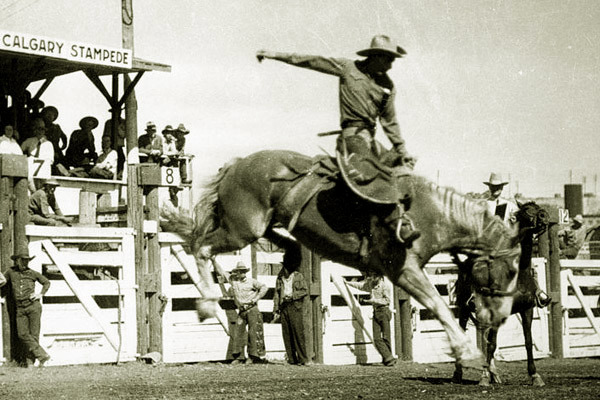
Pete Knight on Silver King, Calgary, 1935.
It has been alleged that Knight suggested to Wilf Carter would do better with the music than in the rodeos and would avoid the risk of serious injury. The Program for the
1936 World Championship contest in Boston, p. 13, noted the risks of the rodeo. The
program noted that cowboys and cowgirls had been killed or seriously injured in various contests. On May 24, 1937, an Associated Press dispatch reported that
Knight had been killed the day before while competing at Hayward, California. It reported that
Knight had been done a header off a horse named "Slow Down" and the hooves of the
horse came down on Knight's chest. Although Knight made it out of the arena, he died in the ambulance on the way to
the hospital. [Writer's note: It is generally regarded that the horse was named
"Duster."]
Wilf Carter went on to become the most famous Canadian cowboy singer. He wrote two songs in
Knight's honor, "Pete Knight, The King of the Cowboys,"and "Pete Knight's Last Ride," the background
music for this page.
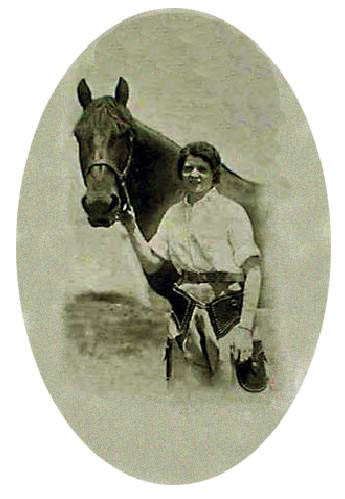 Midnight with Jean Nimmo Dubois, Miss Frontier, 1931
Midnight with Jean Nimmo Dubois, Miss Frontier, 1931
Midnight was on the rodeo circuit
from 1923 until 1933. Midnight was mixed
throroughbred, morgan and percheron and at his peak weighed 1300 lbs. He had been discovered by Alberta ranchman, Jim McNab when he and his top
hand were both thrown by the horse. Midnight's fame was such that when Denver's National Western Stock
Show added a rodeo in 1931, the star attraction was Midnight. Midnight threw all who tried to ride him. The
first, a cowboy movie star, was thrown on the first jump. The exact number of men
who succeeded in riding Midnight may never be known. The first to ride Midnight was Pete Bruised Head,
a Canadian Indian, who rode the horse at Fort Macleod, Alberta. But then it was not
an "approved" rodeo. Except for Bruised Head, numbers range from none to nine. Some give, credit for the first ride to Pete Knight at
Montreal. Knight, however, lasted only eight seconds, when at the time ten seconds was required. Others claim that Knight
succeeded at Cheyenne, but again Pete lasted only 7 1/2 seconds. A cowboy from easter Oregon, E. F. Studnick (1902-1930) claimed that he stayed on for the
full ten seconds at Pendleton. See Athena Press,Sept 4, 1931, p. 2 and Medfort, Mont. Tribune Sept 2, 1931. Howver Studnick's claim was denied by Vern Elliot amd Ed McCarty,
the owners of the horse. The Billins Gazette, Sept 2, 1931, p 10, reported:
News dispatches from Pendleton, Ore., Sunday said Midnight had been
ridden by F. E. Studnick. Oregon cowboy who won the bucking championship
at the annual Pendleton round-up. McCarty and Elliott said Tuesday the
horse had not been ridden by Studnick. They said Midnight threw the
Oregon cowboy in six seconds. The horse has been performing In the rcdeo
arena four years and during that time has thrown every rider that mounted
him, McCarty and Elliott said. He has appeared at Cheyenne Frontier Days
celebration each season and is well known at other major rodeos
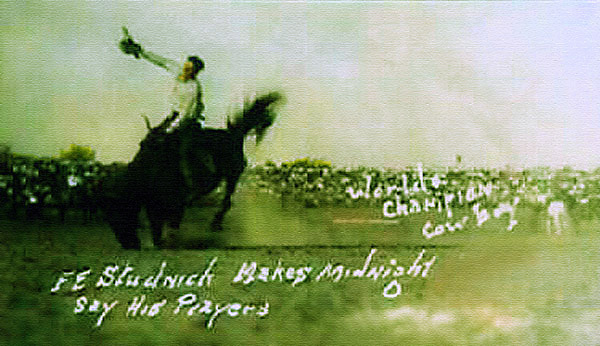
F. E. Studnick on Midnight, Pendleton, 1929.
In a book review of Mary-Ellen Kelm's "A Wilder West: Rodeo in Western Canada,"
J. Edward Chamberlin, B. C. Sudies, Winter 2013-014, p. 189-191, noted:
"Midnight was a horse that no one
could ride – not even the renowned
Pete Knight, who tried four times
(probably chuckling over their names
as he picked himself up off the ground)."
All rode Midnight, the question is For how long?
Midnight retired to Platteville, Colorado, and died in 1936. At the 1937 Denver Stock show,
the crowd stood for a minute of silence in tribute to Midnight.
A life-size bronze statue has been erected in
Midnight's honor in front of the Amon G. Carter Jr. Exhibits Hall in Fort Worth. Midnight
died in 1934. He is buried at the National Cowboy Hall of Fame. Midnight's grave marker reads:
Under this sod
lies a great bucking hoss;
There never lived
A cowboy he counln't toss.
His name was Midnight,
His coast as black as coal,
if there is a hoss-heaven,
Please God, rest his soul. |
Miss Dubois was the first "Miss Frontier. Selection was made by the number of tickets sold
by her sponsoring organization, the Cheyenne Post of the American Legion.
Midnight and another famous horse, Five Minutes to Midnight (1924-1947), also from
Canada, were owned by Vern Elliott and Ed McCarty who are discussed
on a subsequent page.
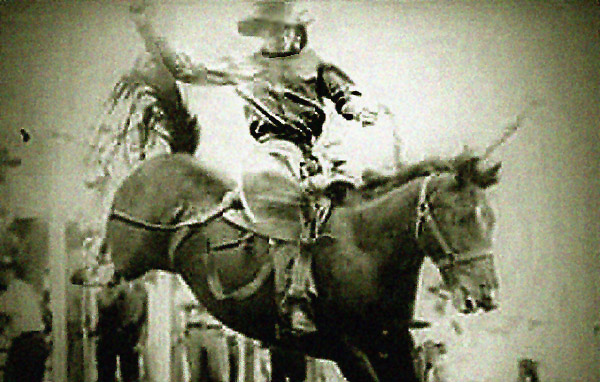
Pete Knight on Five Minutes to Midnight, Chicago, 1933.
Five Minutes to Midnight, also originally from Alberta, was originally named Tumbling Mustard. His name was allegedly
changed as a result of being slightly smaller than Midnight, only 900 lbs. Five Minutes to
Midnight reired in 1946 and died in 1947.
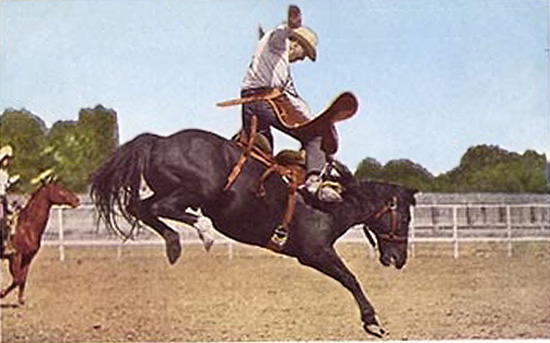
Five Minutes to Midnight.
Another bronc whose name reflected that of Midnight and Five Minutes to Midnight was "11:55 P.M."
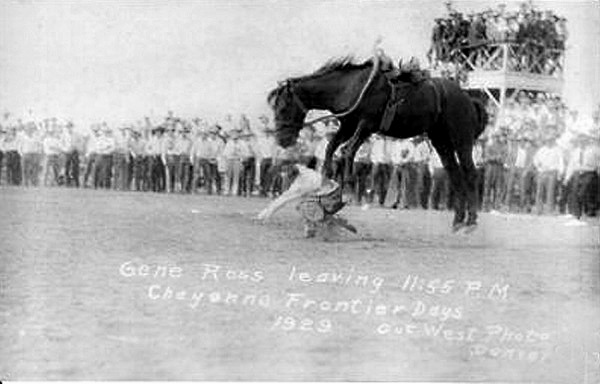
Gene Ross Thrown from 11:55 p.m., Frontier Days, 1929.
Gene Ross (1904-1988) was primarily noted for Steer Wrestling winning the World Championship in that catagory in 1929, 1931 and 1937. It has been
alleged in the saddle bronc catagory he one time rode with his leg in a cast.
See Allen, Michael, "Rodeo Cowboys in the North American Imagination," Univrsity of Nevada Press, 1998, p. 71.
Muisic this page: "Pete Knight's Last Ride" as composed and sung by Wilf
Carter.
Next page: Frontier Days continued.
|